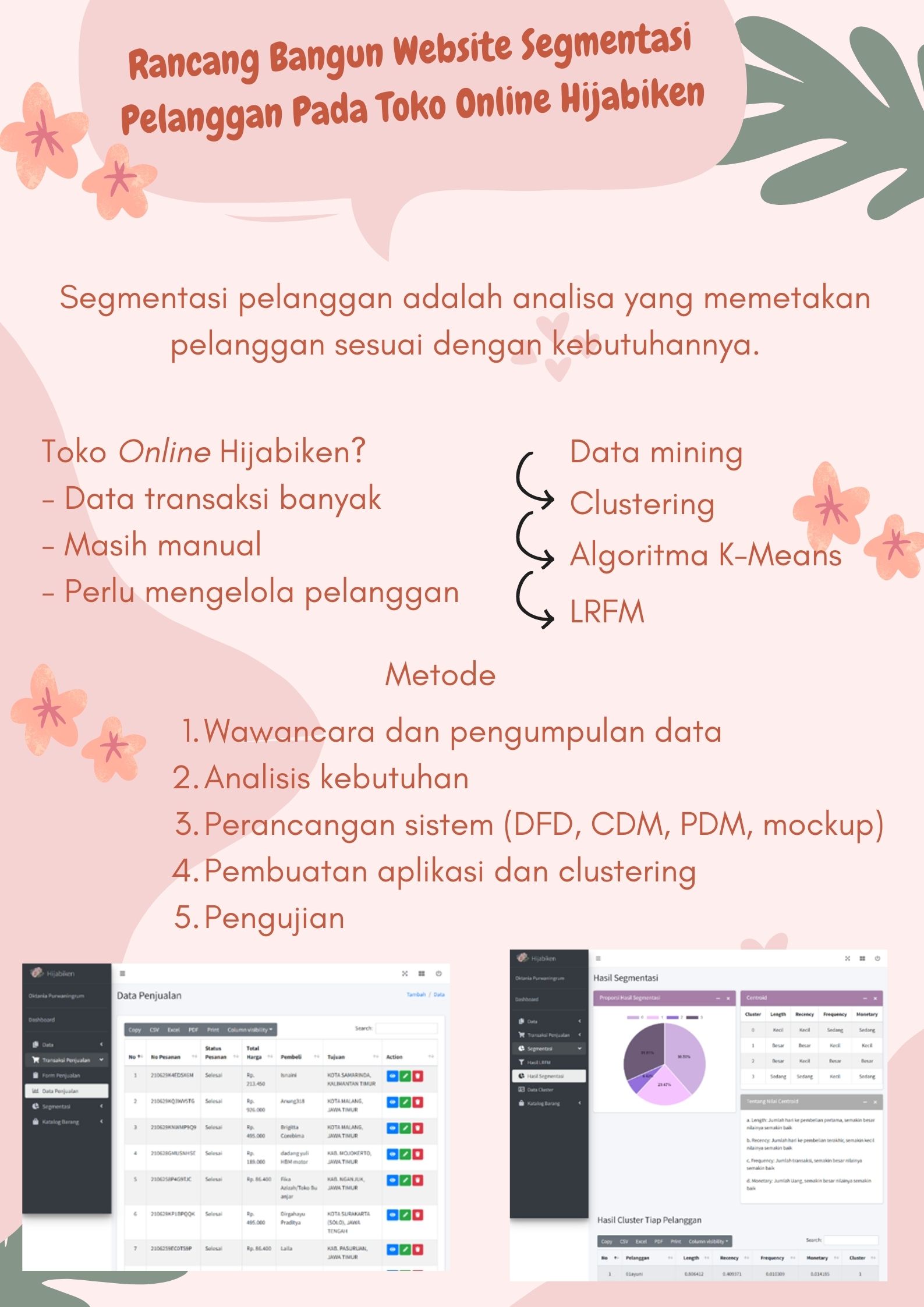Design and Build a Customer Segmentation Website at the Hijabiken Online Store
Rancang Bangun Website Segmentasi Pelanggan Pada Toko Online Hijabiken
DOI:
https://doi.org/10.21070/pels.v2i2.1286Keywords:
Clustering, Customer Segmentation, K-Means, LRFM, WebsiteAbstract
Data can be processed to produce useful information for an organization/company. Example of transaction data that is processed to segment customers. Customer segmentation needs to be done so that sellers can find out market conditions and can be taken into consideration in developing marketing strategies. Customer segmentation can also make sellers know their customers well. Of course, customer segmentation needs to be done at the Hijabiken Online Store, this store sells Muslim products such as hijabs. Seeing the current conditions in the store, data storage is still manual which can be prone to damage and loss. Therefore, in this study, we will build a website that can store and process transaction data. Website design using DFD, CDM, PDM, and mockups. Segmentation is carried out using data mining science in the clustering process. Clustering is done with the K-Means algorithm and LRFM model. The results of testing every function of the website can be run properly.
Downloads
References
N. F. B. Duja, “IMPLEMENTASI FUZZY C-MEANS DAN MODEL LRFM UNTUK SEGMENTASI PELANGGAN (STUDI KASUS : PT. ALIF DUTA PERSADA),” 2018.
S. Monalisa, “Analysis Outlier Data on RFM and LRFM Models to Determining Customer Loyalty with DBSCAN Algorithm,” Proceeding - 2018 Int. Symp. Adv. Intell. Informatics Revolutionize Intell. Informatics Spectr. Humanit. SAIN 2018, pp. 1–5, 2019, doi: 10.1109/SAIN.2018.8673380.
S. Monalisa, “Klusterisasi Customer Lifetime Value dengan Model LRFM menggunakan Algoritma K-Means,”
J. Teknol. Inf. dan Ilmu Komput., vol. 5, no. 2, p. 247, 2018, doi: 10.25126/jtiik.201852690.
A. Muhidin, “Analisa Metode Hierarchical Clustering dan K-Mean dengan Model LRFMP pada Segmentasi Pelanggan,” SIGMA, J. Teknol. Pelita Bangsa, vol. 7, no. 1, pp. 82–83, 2017.
A. Chusyairi and P. R. N. Saputra, “Perbandingan Algoritma Fuzzy C-Means Dan K- Means Clustering Dalam Pengelompokan Data Puskesmas,” CITISEE 2019, pp. 1–6, 2019.
S. A. K. Melati and A. Wibowo, “Segmentasi Pelanggan Menggunakan Metode K-Means Rintisan Penyedia Tenaga Kerja,” J. Ilm. Ilmu Komput., vol. 6, no. 2, pp. 15–19, 2020.
A. Rafika, “Segmentasi Pelanggan Menggunakan Som, Algoritma K-Means Dan Analisis Lrfm Untuk Penyusunan Rekomendasi Strategi Pemasaran Pada Klinik Kecantikan Nanisa, Sidoarjo,” 2015.
F. Juniati, S. Monalisa, R. Zafa, and M. Muslim, “KLASTERISASI CUSTOMER LIFETIME VALUE DENGAN MODEL LRFM MENGGUNAKAN ALGORITMA Fuzzy C-Means,” J. Ilm. Rekayasa dan Manaj. Sist. Inf., vol. 6, no. 1, p. 38, 2020, doi: 10.24014/rmsi.v6i1.8635.
M. T. Dharmawan, N. Y. Setiawan, and F. A. Bachtiar, “Segmentasi Pelanggan Menggunakan Metode Fuzzy C- Means Clustering Berdasarkan LRFM Model Pada Toko Sepatu ( Studi Kasus : Ride Inc Kota Malang ),” J. Pengemb. Teknol. Inf. dan Ilmu Komput., vol. 3, no. 2, pp. 1978–1985, 2019.
D. P. Hidayatullah, R. I. Rokhmawati, and A. R. Perdanakusuma, “Analisis Pemetaan Pelanggan Potensial Menggunakan Algoritma K-Means dan LRFM Model Untuk Mendukung Strategi Pengelolaan Pelanggan ( Studi Pada Maninjau Center Kota Malang ),” J. Pengemb. Teknol. Inf. dan Ilmu Komput., vol. 2, no. 8, pp. 2406–2415, 2018.
D. Nataniel and H. R. Hatta, “Perancangan Sistem Informasi Terpadu Pemerintah Daerah Kabupaten Paser,” vol. 4, no. 1, pp. 47–54, 2009.
R. Sherman, Business Intelligence Guidebook. 2015.
Technopedia, “What is a Physical Data Model? - Definition from Techopedia,” Techopedia.com. [Online]. Available: http://www.techopedia.com/definition/30600/physical-data-model. [Accessed: Sept. 19, 2022]




